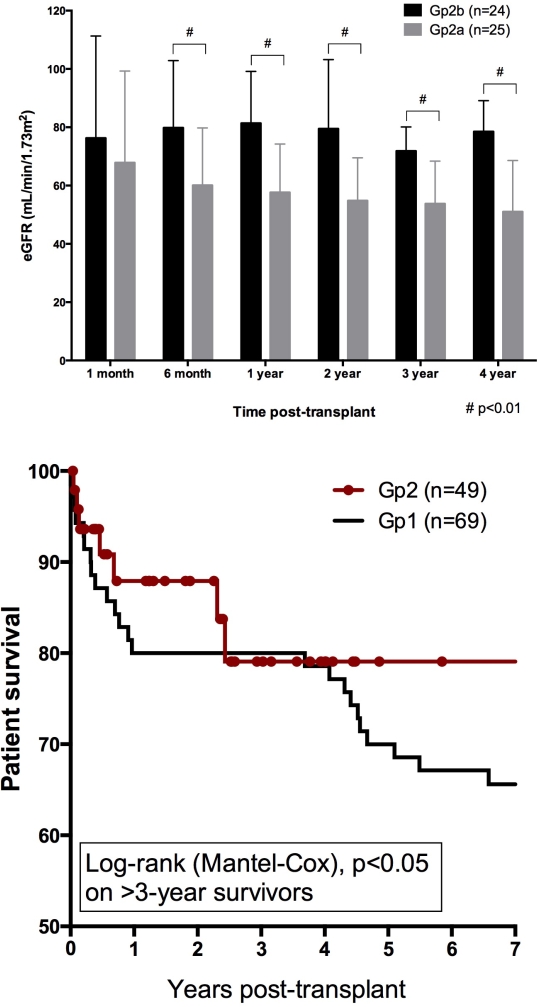Delayed Kidney Transplant in Combined Liver-Kidney Transplantation Improves GFR and Patient Survival
Transplant Division, Department of Surgery, Indiana University, Indianapolis.
Meeting: 2015 American Transplant Congress
Abstract number: 56
Keywords: Kidney/liver transplantation, Outcome, Pulsatile preservation, Survival
Session Information
Session Name: Concurrent Session: Optimizing Renal Outcomes in Liver Transplantation
Session Type: Concurrent Session
Date: Sunday, May 3, 2015
Session Time: 2:15pm-3:45pm
 Presentation Time: 2:27pm-2:39pm
Presentation Time: 2:27pm-2:39pm
Location: Room 118-AB
Background: Patients requiring combined liver-kidney transplantation (LKTx) are at risk for worse outcomes compared to LTx and KTx alone due to severity of illness and complexity of the procedure. Delayed function of the renal graft (DGF) can result from hypotension and pressor use related to the LTx procedure. Delayed Tx of the kidney graft post-LTx may allow stabilization of hemodynamics and coagulopathy.
Methods: 118 LKTx were performed between 2002-2014 at our center. All kidneys underwent continuous hypothermic pulsatile perfusion until Tx; 69 with simultaneous KTx (at time of LTx, Gp1) and 49 with delayed KTx (Gp2) (performed at a later time as a second operation). In each case, the kidney was transplanted through a separate Gibson incision in the left pelvis. All patients received same immunosuppression and continuous veno-venous hemodialysis during the LTx which was continued until KTx. DGF was defined as the need for dialysis in the 1st week after KTx.
Results: Recipient and donor characteristics were comparable in both groups, except more ECD (p<0.05) and DCD (p<0.05) donors were used in Gp2. The mean MELD score was 26.3. Mean liver cold ischemia time (CIT) was comparable (<7h) in both groups, while kidney CIT was 10±3 (range 5-19) and 47±15 (range 20-77) hours, for Gp1 and Gp2 (p<0.001), respectively. DGF rate was 7% in Gp1, however no DGF was seen in Gp2 (p<0.05). Sub-group analyses in delayed KTx group (Gp2) (kidney CIT <48h [Gp2a, n=25], and >48h [Gp2b, n=24]) showed better GFR in Gp2b throughout the study (∼80 vs 60 mL/min, p<0.01). In Gp2b pressor needs decreased 30% compared to 12% in Gp2a at the time of KTx (p<0.05). Figure 1 shows patient survival.
In Gp2b pressor needs decreased 30% compared to 12% in Gp2a at the time of KTx (p<0.05). Figure 1 shows patient survival.
Conclusion: Delayed Tx of the kidney post-LTx (especially if it is delayed >48h) allows; (i) better patient and graft survival in the long-term, (ii) better GFR rates starting from 6 months post-KTx with no DGF, (iii) the use of more ECD and DCD kidneys, and (iv) flexibility for the management of patients and personnel at a high-volume center.
To cite this abstract in AMA style:
Ekser B, Goggins W, Mangus R, Nagai S, Kubal C, Fridell J, Kinsella S, Powelson J, Tector A. Delayed Kidney Transplant in Combined Liver-Kidney Transplantation Improves GFR and Patient Survival [abstract]. Am J Transplant. 2015; 15 (suppl 3). https://atcmeetingabstracts.com/abstract/delayed-kidney-transplant-in-combined-liver-kidney-transplantation-improves-gfr-and-patient-survival/. Accessed December 19, 2025.« Back to 2015 American Transplant Congress
